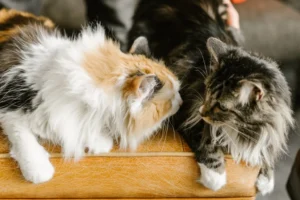Have you ever noticed that Japanese cats seem to have shorter legs compared to other felines around the world? It’s a charming and distinct characteristic that sets them apart. So, why do Japanese cats have short legs? Let’s explore the fascinating reasons behind this unique trait.
The History of Japanese Cats
Have you ever wondered why Japanese cats have those adorable short legs? Well, let’s delve into the historical background to uncover some fascinating insights. Cats have been a cherished companion in Japan for centuries, with records dating back to the Nara Period (710-794 AD). During this time, cats were revered for their hunting skills and protection of precious silk worms.
Selective Breeding Influence : Over time, Japanese breeders selectively bred cats to enhance certain physical characteristics, including their compact and muscular bodies. This intentional breeding likely played a significant role in the development of the short legs we see in Japanese cats today.
In addition, Japanese folklore often portrays cats as mystical creatures with magical powers. These mythical representations may have influenced the desire to breed cats with distinctive physical features, such as short legs, to further embody their supernatural qualities.
Genetics of Japanese Cats
When it comes to understanding why Japanese cats have short legs, genetics play a crucial role. Specific genetic factors contribute to the unique physical characteristics that define Japanese cats.
Genetic Mutation : One key genetic factor is a natural mutation that affects the development of the legs. This mutation, known as the Munchkin gene, results in shorter legs while maintaining a normal body size. The Munchkin gene is responsible for the distinctively short-legged appearance seen in breeds like the Japanese Bobtail and the Kurilian Bobtail.
Moreover, genetic studies have shown that Japanese cats possess a combination of genes that contribute to their shorter legs. These genetic variations have been passed down through generations, solidifying the unique physical trait of Japanese cats.
Overall, the historical background and genetic factors intricately intertwine to shape the charming short-legged appearance that sets Japanese cats apart from other breeds. Isn’t it fascinating how a blend of history and genetics can create such unique and adorable feline companions?
Adaptation to Environment
Japanese cats with short legs, such as the Munchkin breed, have likely adapted to their environment over time. In Japan, where space can be limited indoors, shorter legs may help these cats navigate through tight spaces more easily. Additionally, shorter legs could be an advantage in a country prone to natural disasters like earthquakes, as they may be more stable on uneven surfaces. This adaptation could have helped Japanese cats survive and thrive in their unique environment, making them well-suited for the challenges they face.
Comparison to Other Breeds
When compared to similar breeds around the world, Japanese cats with short legs stand out for their unique appearance and adaptability. While Munchkin cats are known for their short legs, they are not hindered by this physical trait and can move around just as well as cats with longer legs. This sets them apart from other breeds and showcases how their short legs have not limited their abilities or quality of life. If you’re looking for a cat that’s both cute and highly adaptable, a Japanese cat with short legs might be the perfect fit for you.
Fun Fact: Did you know that the Munchkin cat breed, known for its short legs, was first officially recognized in the 1990s, despite reports of similar cats dating back to the 1940s? This unique breed has been capturing hearts worldwide with their adorable appearance and playful personalities.
The Popularity of Munchkin Cats
If you’ve ever wondered why Japanese cats have those adorable short legs, you’re not alone! These charming felines share a unique trait with a particular cat breed called Munchkin cats. Munchkin cats are known for their distinct short legs, which are a result of a genetic mutation. Interestingly, this mutation causes the long bones in their legs to grow shorter than usual, giving them their signature low-to-the-ground appearance. Japanese cats with short legs are often mistakenly believed to be a specific breed, but in reality, they simply share a genetic similarity with Munchkin cats.
A fun fact about Munchkin cats is that they have gained significant popularity due to their endearing appearance. Their short legs and playful nature make them incredibly charming companions for cat lovers worldwide. Despite their unique physical feature, Munchkin cats are generally healthy and agile, proving that short legs don’t hold them back from living a fulfilling and active life. If you’ve ever been captivated by Japanese cats with short legs, their connection to the beloved Munchkin breed sheds light on the fascinating world of cat genetics.
Myths and Misconceptions
Let’s debunk some common myths and misconceptions surrounding Japanese cats with short legs. One prevalent misconception is that these cats are a distinct breed with artificially shortened legs. In reality, their short legs are a natural genetic trait shared with Munchkin cats. Another myth is that their shortened limbs affect their quality of life or mobility. Contrary to this belief, Japanese cats with short legs are just as capable and agile as their longer-legged counterparts.
It’s essential to understand that the genetic mutation causing short legs in these cats is not a hindrance but rather a unique characteristic that sets them apart. Embracing their distinctive appearance and recognizing the genetic connection to Munchkin cats can enhance your appreciation for these charming felines. By dispelling these myths and misconceptions, we can celebrate the diversity and beauty of Japanese cats with short legs, showcasing the wonders of nature’s fascinating genetic variations.
Interesting Facts About Japanese Cats
Japanese cats are not only known for their short legs but also for their unique personality traits. They are often described as independent, intelligent, and playful companions. These felines are highly adaptable to various environments and have a strong sense of curiosity.
One interesting fact about Japanese cats is that they have a rich history in Japanese culture. They are often depicted in traditional art, literature, and folklore as symbols of good luck and prosperity. In Japan, the Beckoning Cat or “Maneki Neko” is a popular talisman believed to bring fortune to its owner.
Another fun fact is that Japanese cats have a wide range of coat colors and patterns, making each cat unique and beautiful in its own way. From solid colors like black and white to intricate patterns like calico and tortoiseshell, Japanese cats come in a variety of stunning looks.
Furthermore, Japanese cats are known for their cleanliness and grooming habits. They spend a significant amount of time grooming themselves, using their tongues and paws to keep their fur clean and well-maintained. This behavior reflects their meticulous nature and attention to hygiene.
Overall, Japanese cats have a rich cultural significance and unique characteristics that make them beloved companions in households around the world. Their short legs may be one distinctive feature, but their fascinating personalities and history add depth to their charm.
- Japanese cats are often portrayed in Japanese folklore as mystical creatures with supernatural abilities.
- The Japanese Bobtail is a breed of cat native to Japan and is known for its distinctive tail that resembles a pom-pom.
- In Japanese mythology, the “Nekomata” is a cat yokai that can transform into a human-like creature with magical powers.
Alex, a passionate animal lover, has experience in training and understanding animal behavior. As a proud pet parent to two dogs and three cats, he founded AnimalReport.net to share insights from animal experts and expand his knowledge of the animal kingdom.









